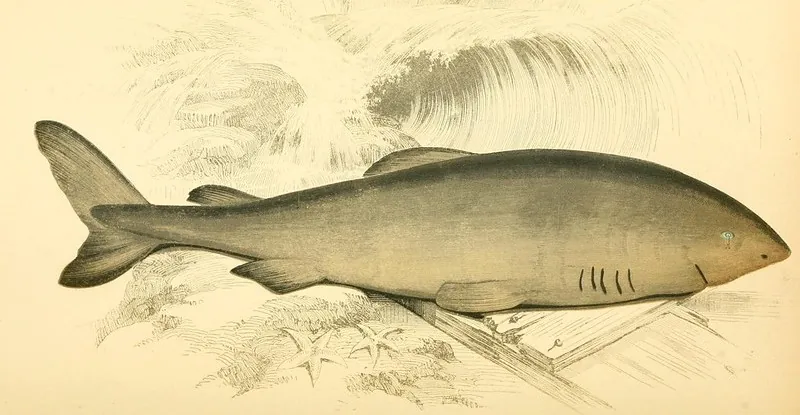
The Timeless Guardians of the Deep: Unraveling the Mystery of the Greenland Shark
2024-11-12
Author: Arjun
The Greenland Shark: A Testament to Longevity
In an age where life is fleeting and constant change is the norm, the Greenland shark stands as a profound testament to longevity and endurance. Despite the chaos that has transpired above the waves, from global pandemics to environmental upheavals, these ancient creatures have silently patrolled the frigid depths of the North Atlantic for centuries, observing the world’s evolution while remaining enigmatic and elusive.
The Oldest Vertebrate
The Greenland shark holds the prestigious title of planet's oldest vertebrate, a fact not realized until recent scientific advancements illuminated its age. Danish physicist Jan Heinemeier made a groundbreaking discovery by analyzing the lens proteins of the shark’s eyes through carbon-14 testing. This method revealed that some individuals may be over 500 years old, having swum in the oceans since before the Age of Enlightenment. Imagine a creature alive long before the first skyscraper graced the horizon!
Physical Characteristics
This remarkable species can reach astonishing lengths of up to 23 feet, with the largest recorded female estimated to be between 272 and 512 years old. Their age is reflected not in beauty but rather in their peculiar appearance—blunt-faced with stunted fins. Additionally, these sharks host a parasite known as Ommatokoita elongata, which clings to their eyes, further enhancing their uncanny aesthetic.
Unique Adaptations
Not only do Greenland sharks possess the gift of time, but they also possess a unique adaptation that sets them apart biologically. High urea concentrations in their flesh not only help regulate their body’s saline levels but also render them toxic when consumed fresh. To enjoy this delicacy, which some liken to an extremely pungent cheese, the meat must be fermented for several months before it can be safely ingested, illustrating both the cruel and intriguing adaptations of nature.
Diet and Feeding Habits
Despite their massive size and predatory skills, these sharks are slow-moving creatures, averaging around 1.7 to 2.2 miles per hour. Due to their lethargic metabolism, these gentle giants require minimal sustenance—around the caloric equivalent of just a couple of cookies each day—and are known to scavenge the ocean floor, consuming whatever falls into their path, including the remains of seals and even larger marine mammals.
Mysterious Reproduction
A fact that many might find disturbing is the peculiar nature of their reproduction. Unknown to us is how these ancient beings mate or give birth; the depths of their lives remain a mystery. Their mysterious nature contributes to their classification as "near threatened," with overfishing and slow reproductive rates posing significant threats to their population. Females mature slowly, taking an estimated 150 years before they can breed, which complicates conservation efforts in the face of human exploitation.
A Vast Habitat
What is truly astonishing is the potential vastness of their habitat. While traditionally associated with Arctic waters, evidence suggests they could inhabit a far greater range of deep, cold oceanic regions than previously thought, possibly extending to areas near France, Portugal, and Scotland.
Conclusion: Silent Sentinels of the Deep
In a world of perpetual turmoil, the Greenland shark embodies hope and resilience. For centuries, they have withstood the trials of time—natural disasters, human conflict, and climate change—engendering a deep respect for their will to survive. Perhaps by studying and safeguarding these majestic creatures, we can find a way to connect with a world greater than ourselves, guiding us toward a future of coexistence and harmony, even amid chaos. The Greenland shark may not only be the oldest vertebrate; it could also be a silent sentinel, witnessing human history unfold from the darkness of the deep, reminding us that some things in nature endure, despite whatever storms rage above the surface.

 Brasil (PT)
Brasil (PT)
 Canada (EN)
Canada (EN)
 Chile (ES)
Chile (ES)
 España (ES)
España (ES)
 France (FR)
France (FR)
 Hong Kong (EN)
Hong Kong (EN)
 Italia (IT)
Italia (IT)
 日本 (JA)
日本 (JA)
 Magyarország (HU)
Magyarország (HU)
 Norge (NO)
Norge (NO)
 Polska (PL)
Polska (PL)
 Schweiz (DE)
Schweiz (DE)
 Singapore (EN)
Singapore (EN)
 Sverige (SV)
Sverige (SV)
 Suomi (FI)
Suomi (FI)
 Türkiye (TR)
Türkiye (TR)